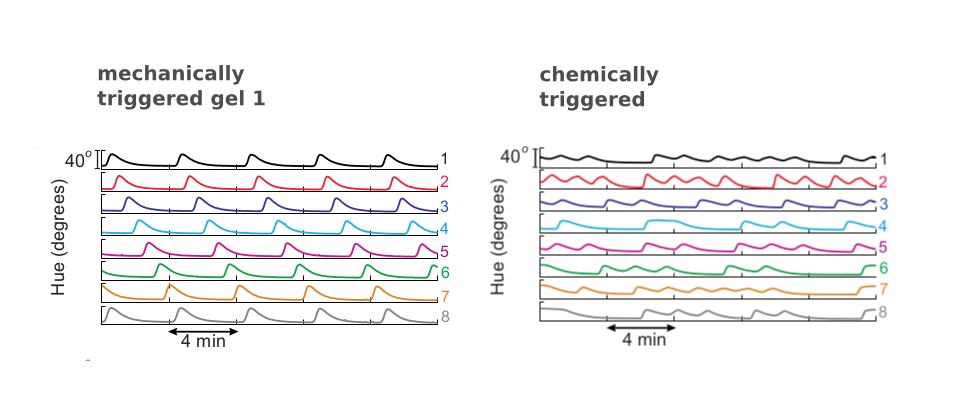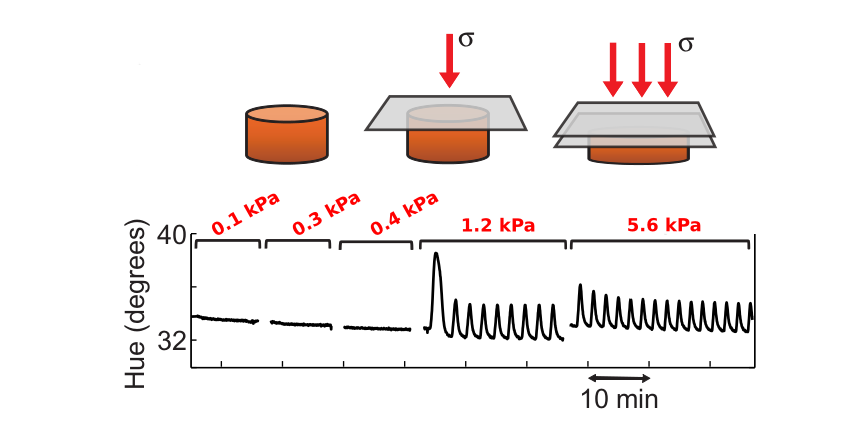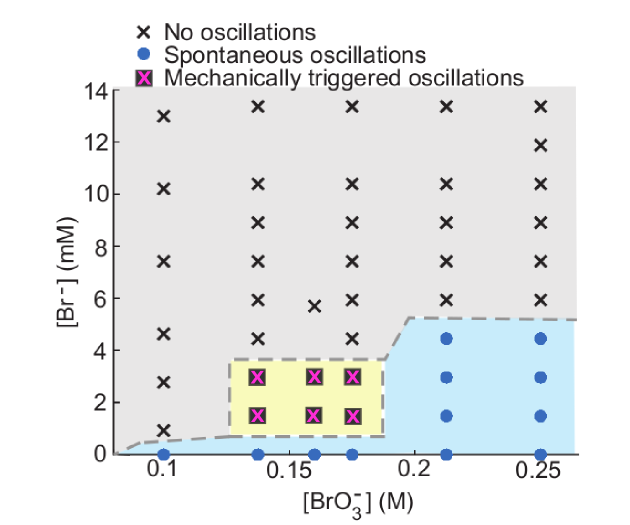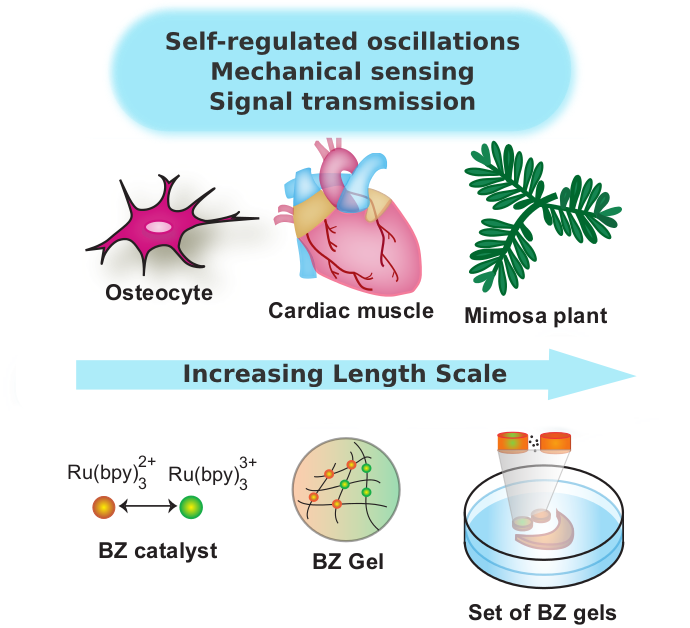
I did my PhD in chemical engineering, and my research required broad knowledge of reaction kinetics, chemical feedback, diffusion, and material science. Specifically, my thesis harnessed an unusual chemical reaction known as the "Belousov-Zhabotinsky reaction" in order to discover new types of material behavior. The Belousov-Zhabotinsky -- or BZ reaction for short -- is a special cocktail of chemicals that produces mesmerizing and colorful spiral patterns that appear to travel through solution for hours at a time.
Rather than describing the dozens of chemical steps that occur during the BZ reaction, I am going to explain this complex phenomena with a simple flowchart:

The BZ reaction is a cyclical reduction-oxidation (redox) reaction. In the center loop of the flowchart above, the Ru(bpy)3 compound alternates between its +2 oxidation state and its +3 oxidation state (indicated by its superscript). Due to its Ruthenium (Ru) core, this compound appears orange-red in the +2 state and green in the +3 state. In the upper portion of the loop, bromate (BrO3) activates the reaction and provides positive feedback. In the lower portion of the loop, malonic acid converts to BrMA which generates bromide ions (Br). Bromide ions inhibit the BZ reaction and provide negative feedback. When the positive and negative feedback balance each other, the BZ reaction can sustain itself for hours at a time.
MOVING AND "BREATHING" BZ GELS
When Ru(bpy)3, the central component of the BZ reaction, is incorporated in a polymer gel, the entire material can undergo the BZ reaction. Depending on how they're made, these so-called "BZ gels" can display interesting wave patterns, and change colors at specific frequencies and amplitudes. You can even prepare them so that they appear to move and breathe on their own. Below is a video that I made of a "breathing" BZ gel. The gel is pulsating and producing synchronized, rhythmic color changes due to the BZ reaction. The fact that the gel pulsates on it's own for hours (even days) without electrical or physical stimulation is quite fascinating:
GETTING BZ GELS to "TALK" to EACH OTHER
Although I was not the first to synthesize these polymer gels, one of my most significant contributions was discovering a new material behavior using the BZ gels. I engineered BZ gels so that they could would respond to external pressure by undergoing the BZ reaction. In other words, I squished BZ gels in order to trigger rhythmic color changes. I was able to tune the frequency, amplitude, and critical stress required to trigger the color changes. Furthermore, I showed that the gels could 'talk' to each other by transmitting chemical signals. In the experimental setup below, I show 8 non-reacting BZ gel discs arranged in a row. When the first gel disc is "squished" by placing a heavy glass slide on top, the BZ reaction is triggered in that gel. Subsequently, it begins transmitting chemical signals to its neighbor. The signal travels from one disc to the next, producing a wave of color change:

Note that the plot on the left shows the data when gel 1 is squished. The BZ wave clearly moves from gel 1 to gel 8. I like to imagine that the gels are playing the children's game of telephone, where each individual gel passes along the message that gel 1 has been squished. The mechanism of BZ gel "communication" is chemical diffusion, which is easy to model mathematically (I won't go into detail here).
The plot above on the right shows data for when the gels are triggered chemically. Because the cue is not localized to gel 1, the waves lack directionality and they "communicate" in a disordered fashion. Imagine a room full of toddlers, and they are all talking at the same time, nobody is listening to each other, and important messages get lost in the disorder of it all!
DEBUNKING THE MAGIC TRICK
Actually, the most impressive part of the telephone experiment is that the first gel can respond to mechanical impact and translate this cue into a chemical message. Early on, I understood that the experiment only worked under certain conditions, but the physical mechanism explaining the phenomena was not immediately obvious to me. And, without a clear mechanism, the BZ reaction is just a magic trick to be rejected by the scientific community.

Shown above is an illustration of how I "squish" BZ gels, along with real data from an experiment. The protocol seems straightforward: monitor the gel while increasing the amount of stress applied to the material. At the critical stress, the gel will begin reacting and changing colors. Note that increasing the stress beyond the critical stress does not change the state of the system. Also, squishing a BZ gel that is already changing colors and reacting does not do anything (e.g., the reaction does not stop). The trickiest part of the experiment is getting the BZ gel in a dormant, yet "triggerable" state. There are a lot of variables that you can tweak when designing a BZ gel experiment: you can change the concentration of any of the 4 main chemical species involved, or you can adjust the reaction temperature, gel size, or polymer volume fraction. Without real upper and lower limits on any of these variables, it's hard to choose where to begin. The current literature at the time explained that BZ gels would stop reacting at very low concentrations of malonic acid (BrMA) or at very high concentrations of BrMA. Unfortunately, my BZ gels always reacted at low concentrations of BrMA. When the gels were exposed to high BrMA, they did not appear to react, but I also could not trigger the reaction by squishing the hell out of them. What was going on?!
BZ GELS AND THE VIRAL DRESS PHOTO
I started my thesis from scratch, meaning that I had to teach myself everything. I synthesized the Ru(bpy)3 compound from raw materials (using flammable chemicals that ignite by touching air), then cooked it into a polymer gel. I even snapped photos of my first successful BZ reactions with a crappy point and shoot. Eventually, I needed to upgrade my setup and my methods, as I found myself constantly asking my labmates: Does the gel look green to you? Or is it yellow? Do you think it just moved? Did it change colors at all? Am I hallucinating? Do you think I'm color blind?
It turns out that I was unable to trigger BZ reactions in my gels at high BrMA concentrations because the gel was actually still reacting, only nobody could see it! Remember the viral "dress" photo where everyone on the internet was arguing over whether the dress was black and blue or white and gold? Well, BZ gels presented a similar problem to me in that there can be bias in the way we see color and our eyes can play tricks on us. Take a look at what the BZ reaction looks like under certain conditions when the amplitude is small:
Most of the literature methods measured the BZ reaction on a grayscale, or using average RGB. I was doing the same thing until I realized that I was throwing away critical information! I needed to determine how to quantify the BZ reaction in a way that was more accurate than my own eyes. Sticking a probe in the gel was not an option because that could nucleate a reaction or otherwise mess up the data.
I ended up measuring the BZ reaction by quantifying hue, which measures color on a cylindrical coordinate system. Below is the data for the video above. Clearly, the gel is reacting but oscillations can only be detected by measuring hue, rather than average RGB. Note that the gel changes in hue by only 5 degrees, whereas the gels in my telephone experiment had amplitudes closer to 40.

BZ GELS AND THE GOLDILOCKS EFFECT
Armed with my new methodology for measuring color, I was able to map the chemical regimes where the BZ gels were reacting or not reacting. I had already gone down the rabbit hole of adjusting BrMA concentrations to control oscillations. If you look at the reaction flowchart again, you'll notice that BrMA generates bromide, which is a reaction inhibitor. It makes sense that high concentrations of BrMA will yield more reaction inhibitor. But why not start out by directly adding bromide to the system? That way, you know exactly what your initial state is. I methodically tested different combinations of bromate and bromide. For each combination, I recorded the BZ gel over time. If the gel was not reacting, then I squished it and continued to record data. I found that BZ oscillations could be triggered by squishing the gel only at certain conditions:

It turns out that the BZ reaction is triggered in the gels when the initial state of the system is on the border dividing the non-oscillatory regime (gray) and the oscillatory regime (blue). Since bromate provides positive feedback, and bromide provides negative feedback, you could also say that BZ oscillations are triggered mechanically when the feedback is just right... Not too much negative feedback, not too much positive feedback, but just the right amount of both.
In addition to mapping out critical regimes, I also measured the critical stress, strain, and Ru(bpy)3 concentrations throughout my squishing experiments. I did this for BZ gels of varying polymer content, because the polymer content affects the mechanical attributes of the material. I discovered that the Ru(bpy)3 concentration was the main driver for mechanically triggering the reaction. Physically, squishing the gel is like compressing a sponge. The gel becomes more dense and the Ru(bpy)3 concentration effectively increases. Below, I show an experiment where oscillations are triggered both by squishing the gel or adding bromate to the system:

The results above agree with Le Chatelier's principle! Scroll back up and look at the reaction flowchart. Increasing Ru(bpy)3 or bromate pushes the BZ reaction
In summary, BZ oscillations can be controlled by craftily balancing the positive and negative feedback, and squishing BZ gels at just the right conditions will nudge the system into an oscillatory regime. And there you have it: I have debunked my magic trick!
BZ GELS AS A BIO-INSPIRED MATERIAL
Throughout my thesis, I drew inspiration from biological systems ranging from individual cells (neurons and osteocytes) to entire organisms (such as the touch-sensitive mimosa pudica plant). In BZ gels, chemical reactions occuring at the nanoscale drive overall system behavior within a single gel and between sets of many gels. Although the mechanism of action for behavior are different in BZ gels versus biological materials, the end results are remarkably similar.
